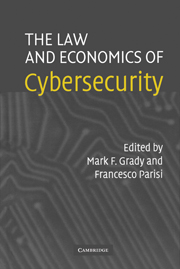Book contents
- Frontmatter
- Contents
- Acknowledgments
- Contributors
- The Law and Economics of Cybersecurity: An Introduction
- PART ONE PROBLEMS
- PART TWO SOLUTIONS
- 5 Network Responses to Network Threats: The Evolution into Private Cybersecurity Associations
- 6 The Dark Side of Private Ordering: The Network/Community Harm of Crime
- 7 Holding Internet Service Providers Accountable
- 8 Global Cyberterrorism, Jurisdiction, and International Organization
- Index
- References
8 - Global Cyberterrorism, Jurisdiction, and International Organization
Published online by Cambridge University Press: 18 August 2009
- Frontmatter
- Contents
- Acknowledgments
- Contributors
- The Law and Economics of Cybersecurity: An Introduction
- PART ONE PROBLEMS
- PART TWO SOLUTIONS
- 5 Network Responses to Network Threats: The Evolution into Private Cybersecurity Associations
- 6 The Dark Side of Private Ordering: The Network/Community Harm of Crime
- 7 Holding Internet Service Providers Accountable
- 8 Global Cyberterrorism, Jurisdiction, and International Organization
- Index
- References
Summary
INTRODUCTION
The rise of cyberspace has greatly facilitated all kinds of activity, including commercial, social, and governmental interaction. There is no doubt that cyberspace today constitutes valuable real estate indeed. We have also routed our control of many real-world processes through cyberspace. Because of this increased value, the security of cyberspace has grown in importance.
The rise of cyberspace and the rise of terrorism may be understood as antagonists in a modernist drama. Both have evolved from state sponsorship into relatively independent and decentralized phenomena. Both exist outside the state. Both use network forms of organization alongside other forms of organization. Cyberspace is both a tool and a target of terrorists. It could also be a tool against terrorists. Most critically, cyberspace is a tool of human interaction and commerce, while terrorism is the nemesis of human interaction and commerce. So, these forces, although similar in structure, are natural opponents.
The rise of terrorism, as one type of asymmetric and distributed warfare, has threatened not only the gains derived from cyberspace but the activities that now come to depend on communication through cyberspace infrastructure. Individuals and governments wish to ensure that they will continue to reap the benefits of cyberspace and that cyberspace controls will not be turned against them. Their enemies see cyberspace as a high-value target. And indeed, during Al Qaeda's reign in Afghanistan, it developed an academy of cyberterrorism, seeking means to attack the cyberspace infrastructure of the West (Gellman 2002).
- Type
- Chapter
- Information
- The Law and Economics of Cybersecurity , pp. 259 - 296Publisher: Cambridge University PressPrint publication year: 2005
References
- 1
- Cited by



